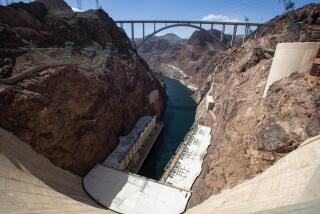MWD Warns Southland Cities to Restrict Water Use
- Share via
Confronted with the fourth consecutive year of drought, officials of Southern California’s largest water agency are calling for mandatory water conservation measures in more than 300 communities stretching from the Mexican border to Ventura County.
The giant Metropolitan Water District, projecting that supplies could fall short of demand by up to 12% in the coming year, is urging its member communities to adopt ordinances to restrict water consumption. The agency also warned that mandatory water rationing may be necessary if the situation does not improve in 1991.
“There is a possibility that (Southern California) could experience shortages . . . even with normal precipitation for the rest of the year,” said Carl Boronkay, general manager of the Metropolitan Water District of Southern California, which supplies more than 500 billion gallons of water a year to the 13 million residents of its six-county service area.
“If (the shortage) is as serious as I think it is, then it’s time we got serious” and began mandatory programs to cut usage, he said.
The Metropolitan Water District is a major supplier of water for Orange County. But, despite signs of impending shortages, officials for several Orange County water districts that are customers of the MWD said they are holding off on calling for mandatory restrictions, at least for the time being.
“We’re evaluating the information we get, but at this point in time, it looks like we will get through without any strict ration ing,” said Larry Sears, water system engineer for the Fullerton municipal water system, which serves about 112,000 residents. As a precaution, the city is already drawing up a draft ordinance to require water rationing, but officials have not yet submitted the ordinance for approval.
Fullerton draws 65% of its water from underground resources, making it less dependent on the MWD than are some area districts.
But even at the Coastal Municipal Water District, which is much more reliant on the MWD, officials said it is too soon to call for mandatory restrictions.
“At this point, I don’t think our district will be recommending a mandatory program,” said district General Manager Hunter Cook. “We’ll all concerned in this, the fourth year of drought, but we’re going to wait and see about restrictions.”
With California’s winter rainy season just about over, snowpack levels are running at less than 63% of normal and river runoff is down to 35% of normal, according to engineers with the state’s Cooperative Snow Survey.
The low precipitation, coupled with cutbacks in California’s share of Colorado River water, are projected to reduce the flow of water to the MWD by about 300,000 acre-feet--or roughly the amount of water used annually by 700,000 households.
Some water officials fear that conservation efforts may not reduce usage sufficiently to avert more severe measures.
“We’re on the borderline of mandatory rationing,” said Dennis Williams, engineer in charge of the city Department of Water and Power’s Los Angeles Aqueduct. “The city of Los Angeles could very well have mandatory rationing,” he said in an interview.
Boronkay said communities need to install mandatory water-saving measures such as bans on hosing down driveways, watering lawns during daylight hours, washing cars and serving water in restaurants without a customer request.
If adopted quickly and enforced strictly, Boronkay said, these measures could keep most of the Southland from later having to take stringent action like that taken by the city of Santa Barbara, where watering lawns is now illegal.
Elsewhere in California, a number of cities, counties and agricultural districts have resorted to rationing.
Monterey is holding consumers to 80% of their past consumption rate, and Santa Clara County has rationed water at 75% of normal. The Central Valley Water Project has cut the flow of water to its largely agricultural district by up to 50%.
Hard-hit El Dorado County has placed a moratorium on new water connections.
Southern California water districts have not yet resorted to such tactics, but most local agencies are drawing upon their so-called “carry-over storage” from previous years.
MWD spokesman Jay Malinowsky said that “is like withdrawing money from the bank. It’s water put away for next year. It’s betting that we’ll get rain by the end of this year.”
The likelihood of significant snow or rain during the remainder of the season is slim, state officials said.
“Most of the (wet) season is over already,” said Jack Pardee of the Cooperative Snow Survey. “The thing is cast now. . . . It’s grim.”
Sierra runoff fell to 63% of normal in 1987. It was 60% of normal in 1988 and 64% last year. This year, runoff was 63% through March 1--but officials say it will probably decline later this spring because snowfall has been light in March, the last month of the rainy season.
“Even if we had rain of Biblical proportions, we couldn’t get back to normal this year,” said Bob Gomperz, a spokesman for the MWD.
The MWD, which operates aqueducts from the Colorado River and Northern California, acts as a wholesaler of water to smaller local water districts. Twenty-seven local water agencies use MWD to supplement their other sources of water. As the drought continued, many of these agencies have increasingly relied on MWD to make up for their own water deficits.
In the past year, Los Angeles’ Department of Water and Power has increased by fourfold its purchases from the MWD. Water from the district now accounts for more than 50% of DWP’s supply, according to the DWP officials. The DWP’s demands will probably rise again next year, they said.
As its purchases increased, the DWP began a voluntary conservation program that encourages Los Angeles homeowners and companies through a variety of measures, including flow restricters on showers.
In Los Angeles, a mandatory conservation law like the one requested by MWD has been on the books since the drought of 1977. If activated by the City Council, the four-step law would prohibit sidewalk washing and restrict use of fountains, and it could escalate to water rationing.
Department of Water and Power officials said Tuesday that they have not yet decided whether to take MWD’s request to the council.
A resolution approved by the MWD’s 51-member board last week “urges all counties, cities, and other local entities in its service area to adopt conservation ordinances designed to mitigate the effects of the continuing drought.”
The MWD cannot force any of its members or the communities it serves to adopt ordinances, but it can make it more difficult or expensive for uncooperative agencies to buy water, Boronkay said.
At the April MWD board meeting, Boronkay said, other such means of encouraging conservation will be addressed.
Every gallon of water saved this year could be critical in quenching Southern California’s thirst next year, Boronkay said.
“Even more significant than this year’s shortages, “ he said, “is the possibility of the drought continuing into a fifth year, at which point our service area could experience water deficiencies in excess of 500,000 acre-feet--enough water to meet the demands of 2.5 million people.”
An acre-foot is 326,000 gallons, enough to cover an acre of land with a foot of water. Two average families use roughly an acre-foot of water a year.
Times staff writer Jim Newton contributed to this story.
MWD SERVICE AREA
The Metropolitan Water District is facing a water shortage of up to 12% this summer. Below, a look at the areas served by MWD. Metropolitan Water District’s member public agencies: (1) Anaheim; (2) Beverly Hills; (3) Burbank; (4) Compton; (5) Fullerton; (6) Glendale; (7) Long Beach; (8) Los Angeles; (9) Pasadena; (10) San Fernando; (11) San Marino; (12) Santa Ana; (13) Santa Monica; (14) Torrance; (15) Calleguas*; (16) Central Basin*; (17) Chino Basin*; (18) Coastal*; (19) Eastern*; (20) Foothill*; (21) Las Virgenes*; (22) Orange County*; (23) San Diego County Water Authority; (24) Three Valleys*; (25) Upper San Gabriel Valley*; (26) West Basin*; (27) Western of Riverside County.*
*Municipal Water Districts; Metropolitan’s clients include 14 cities, 12 municipal districts and one county water authority.
More to Read
Sign up for Essential California
The most important California stories and recommendations in your inbox every morning.
You may occasionally receive promotional content from the Los Angeles Times.













